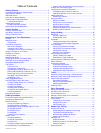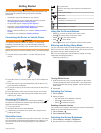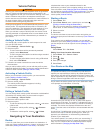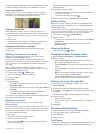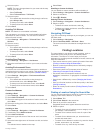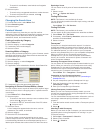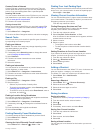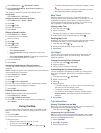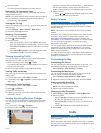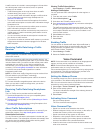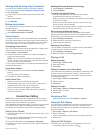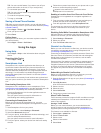
Vehicle Profiles
WARNING
Entering your vehicle profile characteristics does not guarantee
that your vehicle's characteristics will be accounted for in all
route suggestions or that you will receive the warning icons in all
cases. Limitations may exist in the map data such that your
device cannot account for these restrictions or road conditions in
all cases. Always defer to all posted road signs and road
conditions when making driving decisions.
Routing and navigation are calculated differently based on your
vehicle profile. The activated vehicle profile is indicated by an
icon in the status bar. The navigation and map settings on your
device can be customized separately for each vehicle type.
When you activate a camper vehicle profile, the device avoids
including restricted or impassable areas in routes based on the
dimensions, weight, and other characteristics you entered for
your vehicle.
Adding a Vehicle Profile
You should add a vehicle profile for each camper to be used
with your RV 660 device.
1
Select Settings > Vehicle Profile > .
2
Select an option:
• To add a motorhome with a permanently attached
camper, select Motorhome.
• To add a camper pulled behind a vehicle using a standard
hitch, select Trailer.
• To add a camper pulled behind a truck using a fifth-wheel
hitch, select Fifth Wheel.
3
Follow the on-screen instructions to enter the vehicle
characteristics.
After you add a vehicle profile, you can edit the profile to enter
additional detailed information, such as the vehicle identification
number or trailer number (Editing a Vehicle Profile).
Activating a Vehicle Profile
Before you can activate a vehicle profile, you must add the
profile (Adding a Vehicle Profile).
1
Select Settings > Vehicle Profile.
2
Select a vehicle profile.
The vehicle profile information appears, including
measurements and weight.
3
Select Select.
Editing a Vehicle Profile
You can change basic vehicle profile information or add detailed
information to a vehicle profile, such as maximum speed.
1
Select Settings > Vehicle Profile.
2
Select the vehicle profile to edit.
3
Select an option:
• To edit the vehicle profile information, select , and select
a field to edit.
• To rename a vehicle profile, select > > Rename
Profile.
• To delete the vehicle profile, select > > Delete.
Navigating to Your Destination
Routes
A route is a path from your current location to a destination. A
route may include multiple locations, or stops, on the way to the
destination (Adding a Location to Your Route). The device
calculates the route to your destination based on the
preferences you select in the navigation settings, such as the
route calculation mode (Changing the Route Calculation Mode)
and avoidances (Avoiding Delays, Fees, and Areas). The device
can also avoid roads that are not appropriate for the active
vehicle profile (Vehicle Profiles).
Starting a Route
1
Select Where To?.
2
Select Enter Search, enter a search term, and select
(Finding a Location Using the Search Bar).
TIP: You can also search for locations using categories,
search tools, or other methods (Finding Locations).
3
Select a location.
4
Select Go!.
The device calculates a route to the location and guides you
using voice prompts and information on the map (Your Route on
the Map).
If you need to stop at additional locations, you can add the
locations to your route (Adding a Location to Your Route). You
can also shape the route to adjust its course (Shaping Your
Route).
Going Home
Select Where To? > Go Home.
Editing Your Home Location Information
1
Select Where To? > Saved > Home.
2
Select .
3
Select > Edit.
4
Enter your changes.
5
Select Done.
Your Route on the Map
NOTICE
The speed limit feature is for information only and does not
replace your responsibility to abide by all posted speed limit
signs and to use safe driving judgment at all times. Garmin
®
will
not be responsible for any traffic fines or citations you receive for
failing to follow all applicable traffic laws and signs.
As you travel, the device guides you to your destination using
voice prompts and information on the map.
Instructions for your next turn or exit, or other action appear
across the top of the map. The symbol
À
indicates the type of
action and the lane or lanes in which you should be traveling, if
available. The device also displays the distance to the next
action
Á
and the name of the street or exit associated with that
action
Â
.
A colored line
Ã
highlights the course of your route on the map.
Arrows on the map
Ä
indicate upcoming turns. When you
approach your destination, a checkered flag indicates the
location of your destination.
Your vehicle speed
Å
, the road on which you are traveling
Æ
,
and your estimated arrival time
Ç
appear at the bottom of the
map. You can customize the arrival time data field to display
other information (Changing the Map Data Field).
2 Vehicle Profiles





